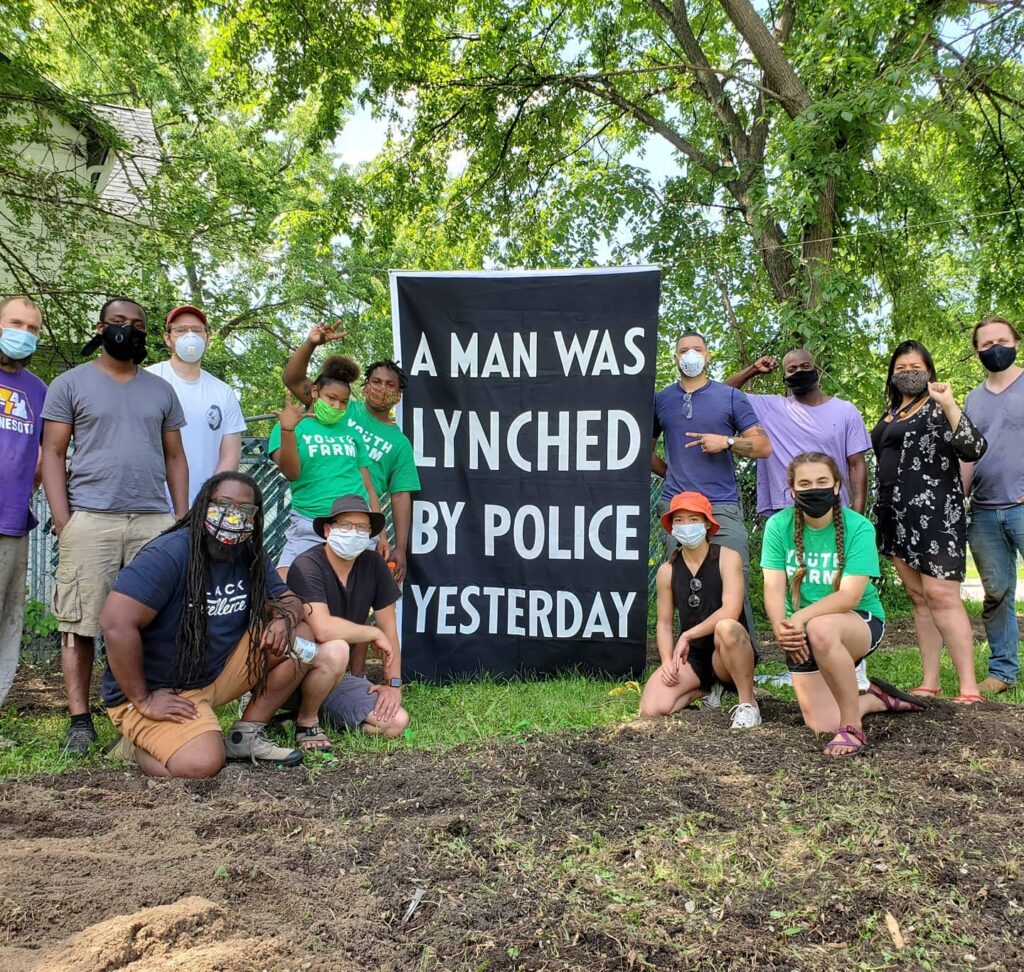
Jordan Weber and “Prototype for poetry vs rhetoric (deep roots)” project participants on site with Dread Scott’s “A Man Was Lynched By Police Yesterday.” Image courtesy the artist.
In late May, the Hawthorne neighborhood of North Minneapolis broke ground at Lyndale Avenue North in a grassy vacant lot adjacent to an alleyway, excavating the land and laying new dirt in a design reminiscent of a basketball court. Just days after those few firelit nights in the city that ignited a new global uprising against racial terror and white supremacy—an ultimate last stand in the face of ceaseless injustice, apparent in the charred remains of a chain grocery store and pharmacy just blocks away—the teamwork on display represents a new chapter in the community: putting down roots that will yield a food forest. Were you to test the soil the volunteers worked, or, if you were raised in the neighborhood, this kind of future natural abundance would be unthinkable from land left criminally polluted by industries that operated for years in this particular area along the Mississippi River. A community targeted for toxification because of its racial makeup, the location had been chosen, as countless sites across the country are, with the correct assumption that pollution in a Black neighborhood would go undetected and undeterred. It did for years. For artist Jordan Weber, this environmental targeting of communities of color is no different from the police’s targeting, explaining, “For me, there’s no separation at all between violence on land, the toxification of land, and violence on the body.” For the former basketball all-star sidelined due to an injury at 20, the court-like design is an approach to engage local youth, particularly young Black men, and “Deconstruct the idea of what the athletic field is, and what it can be turned into that is way more sustainable than this idea of going to NBA.”
40 Acres and a mule has been transformed into a free vacant lot and a dozen people.
For months prior, the Des Moines-based artist had been in discussion with community members, local environmental justice leaders, the nonprofit Youth Farm, and educational staff at the Walker Art Center, where he is an artist in residence, developing the project titled Prototype for poetry vs rhetoric (deep roots). Through ongoing collaboration with volunteers and local youth, the project will eventually produce an urban farm and pollution-mitigation garden and represents Weber’s long-standing engagement with the land, and social and environmental justice, as an art practice particularly adept to respond to the new paradigm of racial reckoning. “This idea of breaking away from structures of systemic environmental racism in society that aren’t sustaining Black and Brown communities have been the same things we’ve been practicing for decades. This isn’t new but it’s critical to connect racial and environmental justice within the arts to sustain progress in the movement while it’s gaining real national focus.”

Protest against police violence in North Minneapolis. Image courtesy the artist.
During his A Blade of Grass Fellowship in 2018, Weber traveled to the place of Malcolm X’s birth, in North Omaha, to construct his 4MXGreenhouse. The space promotes the legacy of Malcolm X in its location and design, replicated from the home the Black power leader was born in, and ethos, modeled on four pillars of Malcolm X’s influence that Weber defines as Self-determination; Detoxification of land, air, and water; Spiritual reflection; and Food and Medicinal supply. Today, the greenhouse not only nurtures seedlings for the Shabazz gardens operated by the Malcolm X Memorial Foundation but people as well, in moments of quiet reflection during meditation classes held in the space, as well as celebration, including the recent wedding of one of the Foundation’s board members. Like his Minneapolis project, the 4MXGreenhouse connects those living in the community not only with the basic human needs that Black, Indigenous, and other people of color have historically been deprived of, such as nutritious food, but also with space to interact with nature and food cultivation, which Weber sees as transformational and therapeutic.

On location at “Prototype for poetry vs rhetoric (deep roots)” in North Minneapolis. Image courtesy the artist.
Though his approach harkens back to the utopian idealists of the 20th-century, who sought to reclaim from industrialized civilization a more peaceful, fulfilling, and agrarian way of life, Weber is realistic about how the “simple life” has historically barred Black and Indigenous people. An Iowa native, the de facto farm capital of the US, he sees displacement and violence, monocropping and food deserts as one long continuum, “The Meskwaki, Sioux, and Ioway tribes, and the ghettoized Black community, are all dealing with the same things.” For Weber, who has been involved in protest movements from Ferguson to Minneapolis, this reclamation of the land represents another form of putting your body on the line in the fight for freedom: “40 Acres and a mule has been transformed into a free vacant lot and a dozen people. We’re going to have to tear the structures down and rebuild them for ourselves at some point because we’re not going to get help from the very systems that are oppressing us.”
Watch a short documentary on Jordan Weber’s A Blade of Grass Fellowship project “4MXGreenhouse,” premiered on ALL ARTS.